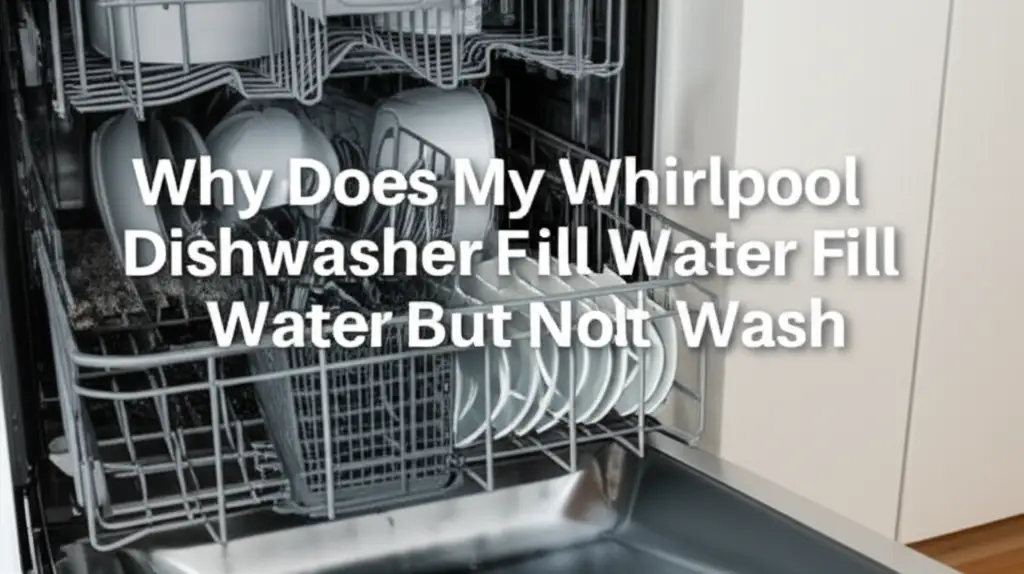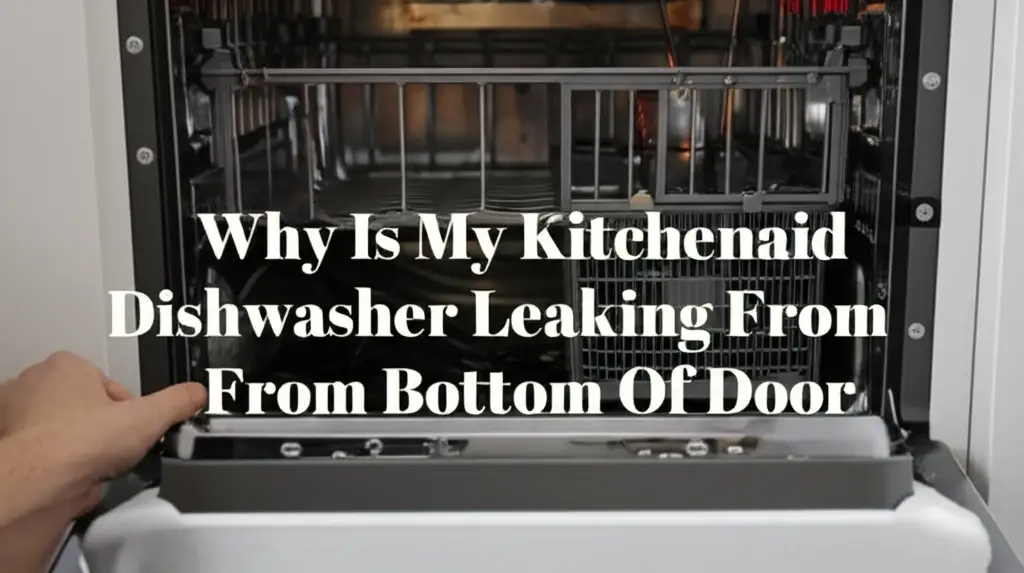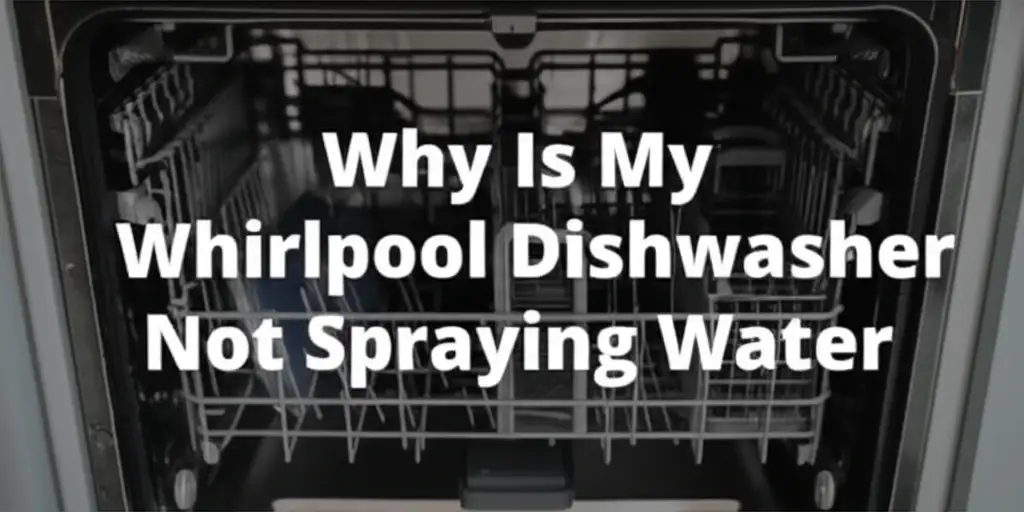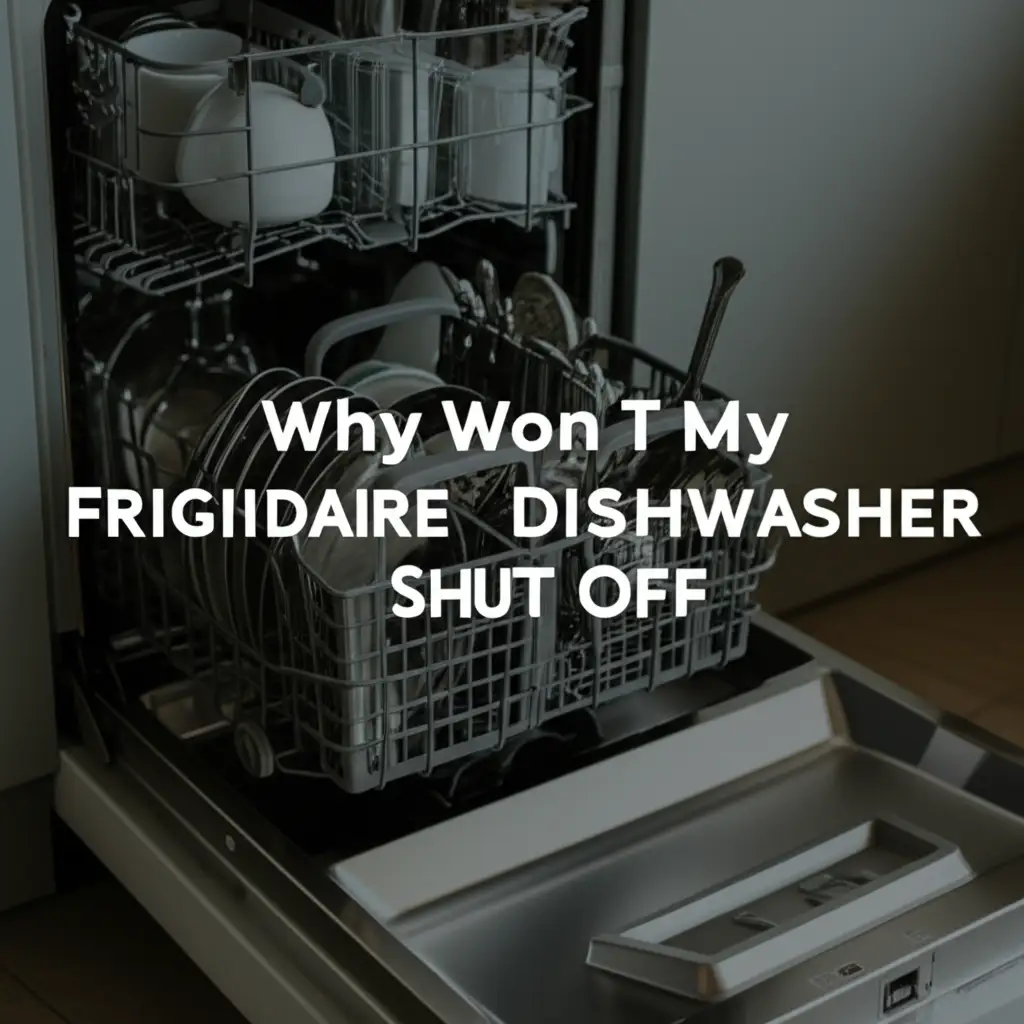· Todd Martin · Appliance Repair · 16 min read
Why Wont My Kitchenaid Dishwasher Fill With Water
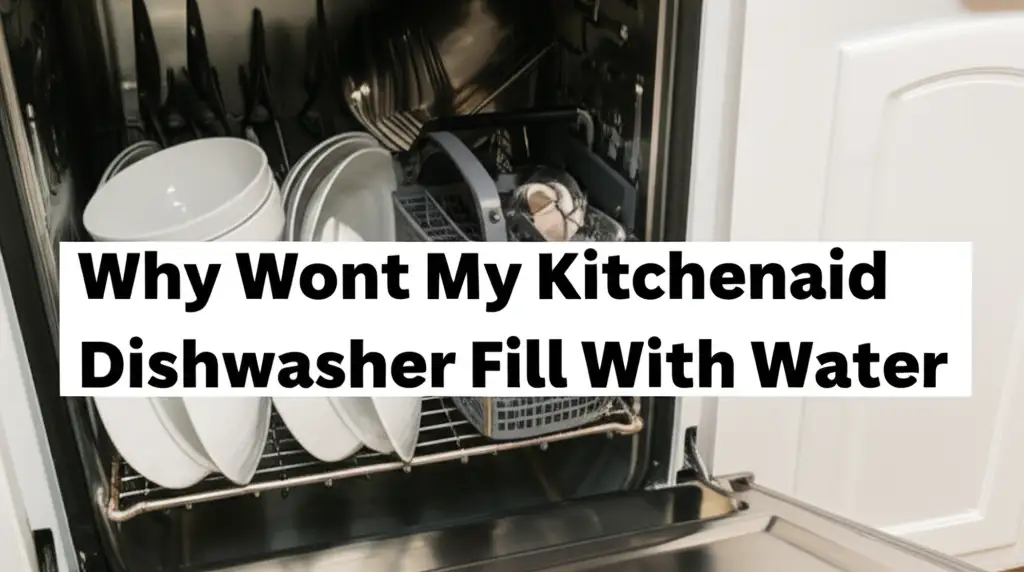
KitchenAid Dishwasher Not Filling: Easy Fixes
It is frustrating when your KitchenAid dishwasher does not fill with water. You load the dishes, select a cycle, and expect clean results. Instead, you hear nothing, or only a hum, and the wash cycle never starts. This common issue stops your cleaning routine and can leave you wondering what to do.
A KitchenAid dishwasher that won’t fill with water usually points to specific problems within its water supply system. Understanding these common culprits helps you find a quick solution. I have seen many cases where a simple check can resolve the issue without needing a professional. This article helps you diagnose why your KitchenAid dishwasher is not filling and guides you through simple troubleshooting steps. You will learn to check everything from the water supply line to the control board, empowering you to get your dishwasher working again.
Takeaway
- Check Water Supply: Ensure the water valve is open and the supply line is not kinked or blocked.
- Inspect Inlet Valve: A faulty water inlet valve is a common reason for no water.
- Clear Float Switch: Make sure the float switch moves freely and is not stuck.
- Verify Door Latch: The door must be securely latched for the dishwasher to start filling.
- Address Drainage Issues: Blockages in the drain system can prevent new water from entering.
- Reset Controls: A simple power reset can sometimes fix electronic glitches.
Why won’t my KitchenAid dishwasher fill with water?
Your KitchenAid dishwasher won’t fill with water if its water supply is off, the water inlet valve is faulty, or the float switch is stuck. Issues like a faulty door latch, clogged drain line, or a malfunctioning control board can also prevent water from entering the tub.
Checking Your Water Supply to the Dishwasher
When your KitchenAid dishwasher won’t fill with water, the first place to look is always the simplest: the water supply itself. You might overlook obvious issues in the rush to diagnose a complex problem. I always start here because it is a quick check that often reveals the root cause. This step can save you time and effort before moving to internal components.
First, locate the water shut-off valve for your dishwasher. This valve is usually under the kitchen sink, near the dishwasher’s supply line. Sometimes, it is behind the dishwasher itself. Make sure this valve is fully open. If it is partially closed, the dishwasher may not get enough water pressure to fill properly. A simple turn can sometimes resolve the entire problem.
Next, inspect the water supply hose that connects the dishwasher to the household water line. This hose can become kinked or bent, restricting water flow. Carefully pull the dishwasher out a little if needed and straighten any kinks you find. Also, check the hose for any visible damage or leaks. A damaged hose can lead to low pressure or no water at all. If the hose looks fine and the valve is open, consider the household water supply. Check if other faucets in your home have normal water pressure. If not, the issue might be with your home’s main water supply, not just the dishwasher. This simple check can save you a lot of time.
Troubleshooting the Water Inlet Valve
The water inlet valve is crucial when your KitchenAid dishwasher is not filling with water. This electromechanical part controls the flow of water into the dishwasher tub. It opens when the control board tells it to, letting water in, and closes when the desired water level is reached. When this valve fails, your dishwasher cannot get water. I often find this part is a common culprit.
A faulty water inlet valve might show several signs. You might hear a faint humming sound but no water entering the tub, or there could be no sound at all from the valve area. Sometimes, the valve can get clogged with mineral deposits or sediment from your water supply. This prevents the valve from opening fully or at all. You will need to turn off the power to the dishwasher before checking this component. Always disconnect the power cord or trip the circuit breaker for safety.
Once the power is off, you can access the water inlet valve, typically located at the bottom front of the dishwasher. Inspect the small filter screen on the valve where the water supply line connects. This screen can trap debris and restrict water flow. Clean it gently if it is clogged. If the screen is clear, but the dishwasher still does not fill, the valve itself might be faulty internally. This often means the solenoid, which opens and closes the valve, has failed. Replacing the entire water inlet valve is generally the most effective fix for a faulty unit. It is a repair many DIYers can handle with the right parts and tools. You can find detailed guides on how to replace the KitchenAid dishwasher water inlet valve if you determine this part is the problem. This step will likely get your dishwasher filling again.
Inspecting the Float Switch Assembly
Another key component when your KitchenAid dishwasher won’t fill with water is the float switch assembly. This small but important part detects the water level inside the dishwasher tub. It acts as a safety mechanism, preventing the dishwasher from overfilling. When water enters the tub, a small float rises. As the water reaches the correct level, the float activates a switch, signaling the control board to stop the water flow. If this float switch gets stuck or malfunctions, it can prevent your dishwasher from filling at all. I always recommend checking this part carefully.
The float switch is usually located at the bottom of the dishwasher tub, often under the lower spray arm or near the drain. You will see a small plastic cylinder or disc that moves up and down. This is the float. Sometimes, food debris, detergent residue, or even a small utensil can get lodged underneath or around the float, preventing it from moving freely. If the float is stuck in the “up” position, the dishwasher’s control system will think the tub is already full of water. It will then prevent the water inlet valve from opening, meaning no new water enters the tub.
To check the float switch, first ensure the dishwasher is off and unplugged. Remove the lower dish rack and any spray arms if necessary to gain full access to the tub’s bottom. Gently press down on the float to ensure it moves up and down easily. If it feels stiff or stuck, clean the area around it thoroughly. Use a small brush or rag to remove any debris. Once you confirm the float moves freely, you can test if this was the issue. If the float moves freely but the dishwasher still does not fill, the switch itself might be faulty. A faulty switch would need replacement, but a good cleaning often solves the problem.
Addressing Door Latch and Switch Issues
Your KitchenAid dishwasher won’t fill with water if the door latch is not fully engaged. Dishwashers have built-in safety features that prevent operation if the door is open or not securely closed. The door latch activates a switch, signaling to the control board that it is safe to begin the cycle and allow water to enter. If this switch is faulty or the latch does not connect properly, the dishwasher will simply not start, which means it will not fill. I have seen many instances where this simple check solves the “no fill” problem.
First, check the door itself. Make sure it closes completely and that you hear a distinct click when you push it shut. If the door does not latch firmly, inspect the latch mechanism on the door and the strike plate on the dishwasher frame. Sometimes, something gets stuck in the latch, or the latch itself becomes bent or worn. A loose latch will not activate the door switch. If the latch appears fine, the problem might be with the door switch itself. This switch is located inside the dishwasher door frame, usually near the latch mechanism. When the door closes, it depresses this switch, completing an electrical circuit.
A faulty door switch will prevent power from reaching crucial components like the water inlet valve. You can try gently jiggling the door or pressing firmly on the latch area after closing the door to see if it makes a difference. If your KitchenAid dishwasher has no power at all, or if it seems to have power but won’t start, the door latch and switch assembly could be the reason. While replacing a door switch might involve some disassembly, ensuring the latch is properly aligned and free of obstructions is always the first step. This ensures the dishwasher knows it is safe to proceed with the wash cycle and begin filling.
Clearing Drain System Obstructions
It might seem counterintuitive, but a KitchenAid dishwasher that won’t fill with water can sometimes be caused by a problem with its draining system. Dishwashers have a sensor that detects if there is standing water in the tub from a previous cycle. If the sensor detects water, it prevents the dishwasher from taking in new water to avoid an overflow. This is a crucial safety mechanism, but it can also be misleading if the drain system is clogged. I often remind people to check drainage even when the issue seems to be about filling.
Begin by checking the bottom of the dishwasher tub for any standing water. If you see water, your dishwasher is likely not draining properly. This residual water tells the machine not to fill again. The first place to check for drain clogs is the filter assembly at the bottom of the tub. Many KitchenAid models have a removable filter that can trap food particles and debris. Remove this filter and clean it thoroughly under running water. A clogged filter severely impacts drainage. You might also want to check if your KitchenAid dishwasher has water in the bottom even when it finishes a cycle. This indicates a drain issue.
Next, inspect the dishwasher’s drain hose. This hose connects the dishwasher to your kitchen sink drain or garbage disposal. It can become kinked, clogged with grease, or have food particles stuck inside. Carefully pull the dishwasher out if needed to access the hose. Look for any bends or obvious blockages. If the hose connects to a garbage disposal, ensure the knockout plug was removed during installation. If the drain hose or air gap (if present) is clogged, it will prevent proper drainage, leaving water in the tub and consequently preventing the dishwasher from filling with fresh water. Clearing these obstructions is vital to allow the dishwasher to recognize it is empty and ready for a new cycle.
Examining the Main Control Board
When your KitchenAid dishwasher won’t fill with water and you have ruled out the more common mechanical issues, the main control board might be the culprit. Think of the control board as the brain of your dishwasher. It receives signals from various sensors, like the door latch and float switch, and sends commands to components like the water inlet valve and drain pump. If this board malfunctions, it can fail to send the command to fill, even if everything else is working correctly. This is less common but certainly possible.
Signs of a failing control board can be erratic behavior, such as cycles not starting, lights flashing randomly, or the dishwasher simply being unresponsive. If your KitchenAid dishwasher has no power, it could be a power supply issue, but if it has power and still won’t fill, the control board might be failing to send the signal to the water inlet valve. Sometimes, a power surge can damage the delicate electronic components on the board. Other times, age and wear can lead to a component failure on the board.
Before considering a replacement, I recommend trying a simple power reset. This often clears minor electronic glitches. To do this, simply disconnect the dishwasher’s power for a few minutes. You can unplug it from the wall outlet or turn off the corresponding circuit breaker at your home’s electrical panel. Leave it off for about 5-10 minutes, then restore power. This can sometimes reset the control board and resolve temporary issues. If the problem persists after a reset, and you are certain all other components are functioning, a professional might be needed to diagnose or replace the control board. This is a more complex repair and often requires specific knowledge of appliance electronics.
Troubleshooting Low Water Pressure and Inlet Screen
Low water pressure can certainly explain why your KitchenAid dishwasher won’t fill with water adequately. Dishwashers need a certain minimum water pressure to operate correctly. If the pressure is too low, the water inlet valve may not open fully, or the dishwasher may take an excessively long time to fill, eventually timing out and stopping the cycle. I always suggest confirming your home’s water pressure. This is an external factor but directly impacts how your appliance functions.
You can easily check your home’s water pressure by observing other faucets in your house. If sinks and showers also have weak flow, the issue might be with your main household water supply, not just the dishwasher. This could be due to municipal water issues, a partially closed main water shut-off valve, or a problem with your home’s pressure regulator. If other faucets have good pressure, then the low pressure might be specific to the dishwasher’s line.
Connected to water pressure is the often-overlooked inlet screen. The water inlet valve, where the supply line connects to the dishwasher, usually has a small mesh screen. This screen acts as a filter, preventing sediment and debris from entering the valve and the dishwasher’s internal components. Over time, this screen can become clogged with rust, limescale, or other particles from your water supply. A clogged inlet screen severely restricts water flow, leading to low pressure at the dishwasher’s entry point, even if your household pressure is fine. To check and clean this screen, you need to turn off the water supply and disconnect the water line from the inlet valve. Gently pull out the screen with pliers and clean it under running water with a brush. Reinstall it carefully. This simple cleaning can significantly improve water flow and resolve filling issues related to low pressure.
Understanding Air Gap and High Loop
When your KitchenAid dishwasher won’t fill with water, it’s worth considering the role of the air gap or the high loop in the drain hose. These components are critical for preventing dirty drain water from flowing back into your clean dishwasher tub. While they are part of the drain system, a blockage or issue with them can indirectly prevent the dishwasher from filling with new water. It’s a common misconception that drain issues only affect draining. I advise checking these points to ensure your system is clear.
An air gap is a small cylindrical device usually mounted on your kitchen counter near the faucet. It creates an air break in the drain line, physically separating the dishwasher’s drain hose from the sink drain. This prevents contaminated water from siphoning back into the dishwasher or your home’s potable water supply. If the air gap itself becomes clogged with food debris, grease, or detergent residue, it can restrict the flow of water. This restriction can cause water to back up, leading to standing water in the dishwasher or preventing the machine from properly sensing it is empty. If water is backed up, the dishwasher’s flood prevention system will activate, preventing any new water from entering the tub.
If your dishwasher does not have an air gap, it likely uses a high loop in its drain hose. A high loop means the drain hose rises above the level of the dishwasher’s drain connection, typically secured to the underside of the countertop. This loop functions similarly to an air gap, using gravity to prevent backflow. If the high loop sags or is not installed correctly, it can lead to drainage problems. A clogged or improperly installed high loop can cause standing water in the tub, mimicking a drain issue. This in turn will tell the dishwasher’s control system that the tub is full. Consequently, the water inlet valve will not open, and the dishwasher will not fill. Checking both the air gap (if present) for clogs and ensuring the drain hose has a proper high loop are important steps in troubleshooting fill issues.
FAQ Section
Q1: Why does my KitchenAid dishwasher start but not fill?
If your KitchenAid dishwasher powers on and makes a noise but doesn’t fill with water, the most common reasons are a faulty water inlet valve or a stuck float switch. The inlet valve might not be opening, or the float switch might falsely indicate the tub is full. Always confirm the door is securely latched too.
Q2: Can I reset my KitchenAid dishwasher to fix filling issues?
Yes, a simple power reset can often resolve minor electronic glitches that prevent filling. Unplug your KitchenAid dishwasher from the power outlet or turn off its circuit breaker for 5-10 minutes. Then, restore power. This can reset the control board and sometimes clear the issue.
Q3: How much water should my KitchenAid dishwasher use per cycle?
A typical KitchenAid dishwasher uses surprisingly little water, often between 3 to 5 gallons per cycle, depending on the model and selected wash cycle. This is significantly less than handwashing dishes. If your dishwasher is not filling at all, it will use zero water, indicating a clear problem.
Q4: What if my KitchenAid dishwasher fills partially then stops?
If your KitchenAid dishwasher fills partially and then stops, it often points to an issue with the water level sensor (float switch) or inconsistent water pressure. The float switch might be intermittently sticking, or your home’s water pressure might fluctuate, causing the dishwasher to pause or abort the fill sequence.
Q5: When should I call a professional for a KitchenAid dishwasher not filling?
You should call a professional if you have checked all the common issues like water supply, inlet valve, float switch, door latch, and drain system, but your KitchenAid dishwasher still won’t fill. Issues involving the main control board, complex electrical problems, or if you are uncomfortable with appliance repairs, warrant professional help.
Conclusion
Having a KitchenAid dishwasher that won’t fill with water can disrupt your daily routine. However, as we have explored, many of these issues are common and often have straightforward solutions. From ensuring your water supply is fully open to checking the water inlet valve and float switch, there are clear steps you can take. I encourage you to systematically work through these troubleshooting tips. Many times, the problem is something simple, like a kinked hose or a piece of debris.
Remember to prioritize your safety by always disconnecting power before inspecting internal components. By following these guidelines, you stand a good chance of diagnosing and fixing why your KitchenAid dishwasher is not filling with water. If you have tried all these steps and the problem persists, do not hesitate to contact a qualified appliance repair professional. They have the tools and expertise to diagnose more complex electrical or component failures. Your clean dishes await!


